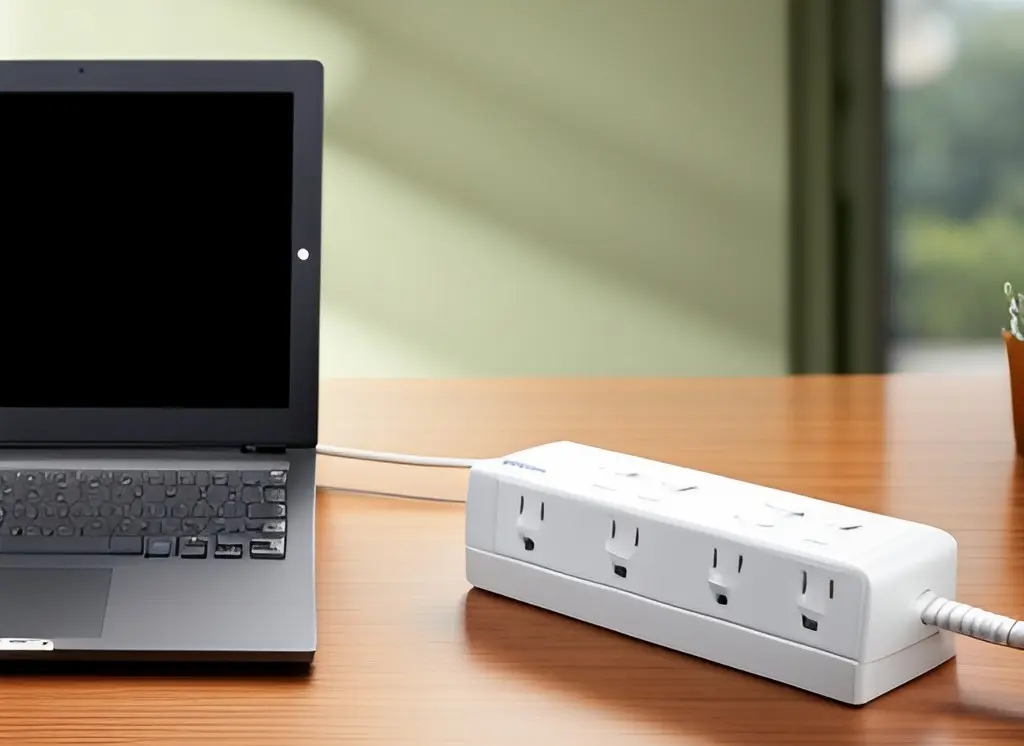As a technician in a large computer industry with over two decades of experience, I’ve witnessed first-hand the havoc an unexpected power surge or failure can wreak on your electronic devices.
Within this guide, you’ll find practical, actionable advice on the critical subject of surge protectors—your first line of defense against volatile electrical currents.
Whether you’re a tech novice or a seasoned enthusiast, this step-by-step guide will provide you with all the insights you need to master surge protectors, and by extension, secure your valuable electronics.
- Understanding Surge Protectors: A Savior for Your Electronics
- Power Surges: More Than Just a Spike
- Why You Need a Surge Protector for Electronic Devices
- Choosing the Right Surge Protector for Your Needs
- Mastering Your Surge Protector Setup
- Effective Maintenance of Your Surge Protector: A Detailed Approach
- Understanding the Risks and Recognizing the Signs of a Failing Surge Protector
- Case Study: Surge Protector in Action
- How Neglecting a Surge Protector Can Lead to Disaster: A Cautionary Tale
- Frequently Asked Questions
- Summing Up
THIS POST MAY CONTAIN AFFILIATE LINKS. As an Amazon Associate, I earn from qualifying purchases. PLEASE READ MY DISCLOSURE FOR MORE INFO.
Understanding Surge Protectors: A Savior for Your Electronics
To truly comprehend the invaluable role of surge protectors, we first need to understand what they exactly are. I’ve seen the effects of power surge damage, and trust me – it’s not a pretty sight.
A surge protector is not just a power strip or an extension cord, it’s your electronic device’s shield against destructive voltage spikes.
This device, built with specialized circuitry, moderates the electric power supply to your gadgets.
The brilliance of a surge protector lies in its ability to sense a power surge and act swiftly. As soon as it detects an excess voltage, it diverts it to the ground, thereby protecting your devices from any potential harm.
Essentially, surge protectors are your first line of defense against unpredictable and harmful electrical currents. Investing in a good one can save your valuable electronics and your peace of mind.
How To Use:
For those who are new to using surge protectors, it’s quite straightforward: simply plug your surge protector into your wall outlet, and then plug your electronic devices into the surge protector.
By taking this important measure, you have now safeguarded your electronics from unexpected power fluctuations.

Power Surges: More Than Just a Spike
Understanding the nature of power surges is key to comprehending the importance of surge protectors. So, what exactly is a power surge?
- In simple terms, it’s an abrupt spike in electrical voltage that occurs in an electrical circuit. The duration of these surges is brief, often only lasting a few nanoseconds, but the damage they can cause is considerable.
Let’s illustrate with an example. Picture a calm river flowing at a steady rate. This represents your regular electrical current.
Now imagine a sudden flood significantly boosting the river’s intensity – this is akin to a power surge. Just as the flood can damage the riverbanks and surrounding areas, a power surge can wreak havoc on your valuable electronics, causing short circuits and overheating.
Power surges can be triggered by multiple sources, from the mundane to the extreme.
Everyday occurrences like electrical grid fluctuations or switching on and off of high-power electrical devices can cause minor surges.
More extreme events, like lightning strikes or malfunctions within your home’s electrical system, can cause severe surges. Therefore, understanding power surges and protecting your devices with a surge protector is paramount to ensuring the longevity of your electronics.
Related: What Not To Do With Your Laptop | 11 Tips
Common Myths and Misconceptions
There are several misconceptions surrounding the use and capabilities of surge protectors. One common myth that requires debunking is the belief that these devices can safeguard against the force of a direct lightning strike. I assure you, this is simply not true.
- While a surge protector is a formidable shield against voltage spikes caused by day-to-day electrical fluctuations or minor power grid disruptions, it is not built to withstand the extraordinary power of a direct lightning hit.
The surge of energy created by lightning is simply too great. A direct strike can generate millions of volts of electricity, far beyond the protective capabilities of a standard surge protector.
So, while a surge protector is an essential instrument in your electronics protection toolkit, remember that it is not an invincible shield.
In the event of a lightning storm, the safest measure is to unplug your devices when possible. This understanding will allow you to maximize the effectiveness of your surge protector and ensure the lasting safety of your electronic devices.
Why You Need a Surge Protector for Electronic Devices
I can’t stress enough the significance of a surge protector in safeguarding your electronic devices, particularly your laptop or computer. Let’s consider an example that most of us can relate to.
Imagine you’re in the middle of an important online meeting, or perhaps you’re just about to hit the ‘save’ button on a document you’ve been working on all day.
Suddenly, a power surge strikes, causing your laptop to shut down abruptly and, worse still, potentially damaging its delicate internal components. A power surge, no matter how brief, could spell disaster for your valuable laptop.
Now, picture the same scenario, but this time, your laptop is connected to a surge protector.
As soon as the power surge hits, the surge protector promptly diverts the excess voltage, ensuring your laptop remains safe and operational. No abrupt shutdowns, no internal component damage, and no loss of your precious work.
The Surge Protector: An Essential Guardian for Your Electronics
A surge protector isn’t just a tool; it’s an investment in the longevity of your electronics, a guardian that shields them from unpredictable and damaging voltage spikes.
It’s about more than just preventing physical damage; it’s about sparing you from unexpected costs, stress, and the disruption of your daily routine.
By investing in a surge protector, you’re taking a proactive step to ensure your peace of mind and the continuous, optimal performance of your laptop.

Choosing the Right Surge Protector for Your Needs
As you now understand, not all surge protectors are created equal. With countless options available on the market, how can you ensure you’re choosing the best fit for your specific needs?
First, know your appliances. Heavier appliances require more robust surge protectors, while simpler devices may only require basic protection.
Secondly, take into account the joule rating — a higher rating means the surge protector can handle more energy, providing better protection.
Lastly, consider the warranty. A good surge protector will offer a warranty for your devices if they are damaged while connected.
Remember, what works for one individual might not work for you. The key lies in understanding your specific needs and doing your research before making a purchase.
Comprehensive Guide to Choosing Your Surge Protector
Choosing the right surge protector for your needs can seem overwhelming, but it doesn’t have to be. Let’s break it down step-by-step, so you can make an informed decision.
- Number of Outlets: Evaluate how many devices you need to protect. For example, if you have a computer setup with a monitor, printer, and speaker system, you would need at least a 4-outlet surge protector. Always consider future device additions too.
- Energy Absorption Rating (Joules): This indicates how much energy the surge protector can absorb before it fails. A higher joules rating equals better protection. For instance, a 1000-joule rated surge protector should be sufficient for a basic computer setup. If you have more expensive or sensitive equipment, you might want to consider a surge protector with a rating of 2000 joules or more.
- Clamping Voltage (V): This is the voltage at which the surge protector will start redirecting excess electricity to the ground. Lower clamping voltage offers better protection. For most home appliances a clamping voltage of 400V or lower is recommended.
- Response Time: A good surge protector should respond instantly (in nanoseconds) to a surge. The lower the response time, the quicker your devices are protected.
- Metal Oxide Varistors (MOV): One common mechanism used in surge protectors is the metal oxide varistor. MOVs are composed of ceramic material with a metal oxide coating. Under normal voltage conditions, the MOV acts as an open circuit, allowing the electricity to flow through. However, when a voltage spike occurs, the MOV’s resistance drops significantly, creating a low-impedance path for the excess voltage. This diverts the excessive energy to the ground, preventing it from reaching connected devices.
- Gas Discharge Tubes (GDT): Another mechanism used in surge protectors is the gas discharge tube. GDTs contain a small amount of gas that ionizes when the voltage exceeds a certain threshold. This ionization allows the excess energy to be redirected through the tube and grounded. GDTs are fast-acting devices that can handle high-voltage surges effectively.
- Warranty: The manufacturer’s warranty can be a good indicator of the confidence they have in their product. Some companies will even offer compensation if your devices get damaged while connected to their surge protector.
- Additional Features: Some surge protectors come with added features like USB ports for charging mobile devices, or coaxial connectors for cable or satellite TV lines. Consider if these could be beneficial for your setup.
Remember, safety and prevention are always less costly than dealing with a device damaged by a power surge. Take time to analyze your needs, compare options, and choose wisely.
Below are just two examples of common household surge protectors. You can buy them on Amazon and As an Amazon Associate, I earn from qualifying purchases.
Types of Surge Protectors: Finding Your Perfect Match
While we have covered the essential features to look for in a surge protector, let’s delve a bit deeper into the various types of surge protectors available in the market. Understanding these categories can further help you make the right choice for your needs:
- Basic Surge Protectors (Strip or Block): These are the most common type, available in various sizes and designs. Ideal for home office setups or living rooms, they offer an affordable way to protect your electronics.
- Wall-Mount Surge Protectors: These surge protectors plug directly into the wall and are a great option if space is at a premium. Some models even offer USB charging ports.
- Whole House Surge Protectors: As the name implies, these protectors safeguard all the electrical devices in your home by installing directly into the home’s electrical panel.
- Battery Backup (UPS) Surge Protectors: These not only protect against surges but also provide battery backup power during a power outage. This is particularly useful for desktop computers and network equipment.
- Portable Surge Protectors: Compact and travel-friendly, these are useful for protecting your laptop and other portable devices when you’re on the go.
- Advanced Power Strips: These surge protectors can automatically turn off power to devices that are not in use, saving energy and reducing utility costs.
To choose the right type, consider the number of devices you need to protect, their cumulative power consumption, location, and of course, your budget.
Also Read: Surge Protectors vs. UPS: A Comprehensive Guide on Power Protection
Mastering Your Surge Protector Setup
Now that we’ve covered the importance and functions of surge protectors, it’s time to dive into the practical stuff – setting up your surge protector correctly.
This segment will give you a detailed, step-by-step guide on how to install and use your surge protector effectively, using real-life examples and practical tips for clarity.
Expert Guide on Surge Protector Installation and Usage:
- Location, Location, Location: The first step is to decide where to place your surge protector. For instance, if you’re safeguarding your home office equipment, place the surge protector on the desk, close to your computer, printer, and other devices. This eliminates the need for long extension cords, which can compromise the effectiveness of your surge protector.
- Plug-in Time: Now, connect your devices to the surge protector. Here’s a tip: don’t overload it. For example, if your surge protector has a maximum load capacity of 15 amps, plugging in a computer (5 amps), printer (5 amps), and a space heater (10 amps) would overload it, which could lead to overheating or even fire hazards.
- Ground Control: This step is crucial – ensure your surge protector is properly grounded. Most surge protectors have a grounding indicator light. If this light is green, it means the surge protector has a safe path to divert any excess voltage, protecting your devices.
- Say No to Motor Loads: Here’s a no-no: don’t plug high-power motor loads, such as fridges or air conditioners, into your surge protector. These devices can cause voltage fluctuations, hampering the performance of your surge protector. It’s best to plug them directly into a wall outlet.
- Routine Check-ups: Regularly inspect your surge protector for wear or damage – frayed cords or loose connections are a sign it needs to be replaced. Even if it looks fine, replace your surge protector every five years, as its protective components can degrade over time.
- Know Your Ratings: Last but not least, get familiar with your surge protector’s voltage and current ratings. Make sure it can handle the electrical demands of your devices to prevent any power-related issues.
An Important Note About Surge Protector Placement
Avoid placing your surge protector on the floor facing upwards. This can lead to dust accumulation, potentially hampering its performance.
Instead, place it on a desk, shelf, or wall-mounted outlet, which allows for better ventilation and reduces the risk of dust interference. Regular cleaning and maintenance are also crucial to ensure the longevity and performance of your surge protector.
So, there you have it – a comprehensive guide on setting up your surge protector to ensure the best protection for your devices. Always remember to prioritize safety and follow the manufacturer’s instructions when handling electrical appliances.
Guided Walk-Through: Setting Up Your Surge Protector with Laptop
Here, let’s follow John, a remote worker who just bought a surge protector for his home-based workstation and wants to connect his laptop to ensure its safety during power surges.
- Unpack and Inspect: John starts by unpacking his new surge protector, carefully examining it for any signs of damage from shipping. He checks the cord and the casing for any obvious defects, confirming that all the outlets and switches are intact and functioning appropriately.
- Location Determination: Next, he decides on the best location for the surge protector, ensuring it is close to his laptop but not in a cluttered area. He places it on a side table, next to his workstation.
- Initial Connection: He then plugs the surge protector into the wall outlet, taking note of the indicator lights. The green grounding light tells him it’s properly grounded and ready for use.
- Device Connection: Now it’s time to connect his laptop. He plugs the laptop charger into one of the surge protector’s outlets, ensuring the plug fits securely.
- Indicator Verification: John checks the indicator lights on the surge protector again. The green “protected” light is on, indicating that his laptop is now safeguarded against power surges.
- Usage and Monitoring: Finally, John starts using his laptop, confident that it’s protected. He makes a mental note to check the surge protector regularly to ensure it’s functioning correctly and considers setting reminders for bi-annual checks.
By following these steps, John has successfully set up his surge protector, providing a secure power source for his laptop. Just like John, always remember to prioritize the safety of your devices by employing a surge protector.
A helpful tip: I find it useful to secure my surge protector vertically to one of the legs of my desk using zip ties.
Effective Maintenance of Your Surge Protector: A Detailed Approach
A surge protector is only as effective as its maintenance. Like any device, a surge protector can wear and tear over time, compromising its ability to safeguard your electronics. To optimize its performance and extend its lifespan, thoughtful care, and regular checks are essential.
- Routine Inspection: Make it a habit to examine your surge protector regularly. Check for any visual signs of damage such as blackened outlets, discolored casing, or a lingering burned smell. For instance, if your surge protector’s casing has turned from a bright white to a discolored beige, it’s a clear sign of overheating and it needs to be replaced.
- Performance Monitoring: Pay attention to the operation of your devices. An unexpected shutdown, flickering screens, or unsteady performance may indicate a faulty surge protector. For example, if your computer crashes unexpectedly or your TV screen flickers when connected to the surge protector, these could be warning signals of an underperforming surge protector.
- Regular Replacement: Even in the absence of visible damage or malfunctioning, surge protectors should be replaced every three to five years. This is because the protective components within the surge protector, like MOVs, can degrade over time, reducing its effectiveness. If your surge protector is more than five years old and has experienced a few power surges, it’s a good idea to replace it.
- Cleaning and Dusting: Dust and grime can hinder the performance of your surge protector. Ensure regular cleaning by gently wiping the exterior with a soft, damp cloth and using compressed air to remove dust from the outlets. Be sure to unplug the surge protector during cleaning to avoid electrical shock.
Remember, your surge protector is your first line of defense in protecting your precious electronics from damaging power surges. Regular maintenance isn’t just about prolonging its life but also about safeguarding your devices and ensuring their optimal performance.
Understanding the Risks and Recognizing the Signs of a Failing Surge Protector
A failing or outdated surge protector can pose several threats to your electronic devices, and hence, it’s crucial to recognize the warning signs early to avoid potential damage.
This section will arm you with the knowledge to identify possible pitfalls and advise you on the actions you need to take.
- Indicator Light Malfunctions: The majority of surge protectors are equipped with indicator lights. These lights serve as a visual aid to ensure that everything is functioning as it should. If the light flickers or doesn’t light up at all, this could be a red flag indicating a malfunctioning surge protector. Don’t overlook these signs – refer to the user manual or reach out to the manufacturer for assistance.
- Visible Wear and Tear: Regularly inspect your surge protector for apparent physical damage such as worn-out cords, misshapen outlets, or cracked casings. These may seem like minor inconveniences, but in reality could compromise the surge protector’s effectiveness and create electrical safety issues. If you spot any physical damage, it’s advisable to replace the surge protector without delay.
- Surge Protector Age: Surge protectors aren’t designed to last forever. A combination of power surges and the natural wear and tear process can degrade a surge protector over time. The general rule of thumb is to replace surge protectors every five years or sooner if the manufacturer suggests. Always keep track of the manufacturing date or the purchase date of your surge protector to make sure it’s within its serviceable lifespan.
- High Incidence of Power Surges: If you’re in an area where power surges occur frequently or if you notice recurring electrical fluctuations, it could take a toll on your surge protector. Constant exposure to power surges can wear down the surge protector’s ability to manage subsequent surges effectively. In such scenarios, consider upgrading to a surge protector with a higher joule rating or consult with a professional electrician to address the root of the electrical issues.
- Damage to Protected Devices: Experiencing damage or malfunctions in your devices connected to a surge protector could signify a failure in the surge protector’s performance. While surge protectors significantly lower the risk of damage, they cannot provide absolute protection. If you detect a cycle of device failures despite their connection to a surge protector, it’s time to thoroughly examine your surge protection setup and consider an upgrade.
Routine checks and timely replacement of surge protectors are key to ensuring uninterrupted protection for your valuable electronic devices.
Case Study: Surge Protector in Action
To help illustrate the importance of surge protectors, we’ll share a case study from my personal and professional experience. This real-life example will highlight the potential consequences of not utilizing a surge protector and demonstrate their effectiveness in a tangible way.
How Neglecting a Surge Protector Can Lead to Disaster: A Cautionary Tale
I’ve encountered numerous instances where the absence of a surge protector led to significant damage. One such case that comes to mind is that of a client. A freelance graphic designer by profession, he had invested heavily in high-end computer equipment. He operated from a home office which was powered by a single power strip, with no surge protector in place.
One night, a bolt of lightning struck a nearby pole, causing a substantial power surge. The power strip failed to offer any protection against the surge, and the resultant spike in electricity fried his equipment, inflicting severe damage. His computer and monitor were rendered unusable. The data loss was not only a financial blow but also resulted in the loss of countless hours of work and delayed project timelines.
If a suitable surge protector had been in place, he could have potentially averted this disaster. Therefore, it’s not just about protecting your devices, but also about saving yourself from potential emotional and financial distress.
Frequently Asked Questions
- What does a surge protector’s Joule rating represent, and why is it significant?
The Joule rating on a surge protector refers to the maximum energy load it can withstand during a power surge before it fails. The higher this rating, the greater the energy it can absorb, thus offering enhanced protection for your electronic devices.
- Is a surge protector capable of withstanding a lightning strike?
Surge protectors are designed to handle small to medium power surges. However, they may not withstand the extremely high energy surges produced by a direct lightning hit. For optimal protection, it is recommended to disconnect your devices during a storm.
- Are power strips and surge protectors identical?
Power strips and surge protectors may appear similar, but they have distinct functions. While a power strip primarily provides additional electrical outlets, a surge protector has the added advantage of safeguarding your devices against power surges.
- What are some reliable brands for purchasing a surge protector?
There are several well-known brands that manufacture high-quality surge protectors, such as Belkin, APC, and Tripp Lite. Your choice of brand should be guided by your specific requirements, budget constraints, and product reviews.
- When should I consider replacing my surge protector?
Typically, surge protectors should be replaced every three to five years. However, if there has been a substantial power surge or the indicator light on the surge protector is not working, it might need to be replaced sooner.
- Is it safe to plug a surge protector into an extension cord?
Plugging a surge protector into an extension cord is usually not recommended as it may pose a fire risk. For safe usage, always connect the surge protector directly to a wall outlet.
- How does a surge protector differ from an Uninterruptible Power Supply (UPS)?
While both devices offer surge protection, a UPS also provides backup power during power outages, allowing you to safeguard your work and shut down your equipment safely.
- Can a surge protector protect my devices from all types of electrical issues?
While surge protectors can guard against power surges, they cannot protect your devices from all electrical problems. For example, they can’t protect your devices from drops in voltage (power sags), frequency variations, or power outages.
- Do all surge protectors have the same number of outlets?
No, surge protectors are available with different numbers of outlets, from a few to over a dozen. The model you select should be based on the number of devices you wish to protect.
Summing Up
Mastering the art of surge protection isn’t just about understanding what surge protectors are and how they work, but also about knowing how to choose the right one and how to maintain it properly.
The peace of mind and the protection it offers to your valuable electronics are truly priceless. Protect your electronics, protect your peace of mind, and invest in a surge protector today.
Remember, the key to ensuring the safety of your devices lies in routine checks, timely replacement, and upgrading when necessary. With a reliable surge protector in place, you can rest easy knowing that your electronics are well-protected from any unforeseen power surges.
Source:
- https://www.energy.gov/energysaver/save-electricity-and-fuel/smart-grid/surge-protectors
- How often should I replace my surge protector? Tripp Lite.
- Guide To Power Strips and Surge Protectors. Underwriters Laboratories. Link

J.S. is the owner, content creator, and editor at Upgrades-and-Options.com. I’ve worked in the IT and Computer Support field for over 20 years. The server hardware in my computer labs has mostly been IBM, but I’ve supported Dell, HP, and various other hardware. In addition, as part of my lab administrator responsibilities, I’ve learned, supported, and repaired/upgraded network hardware such as Cisco routers and switches. READ FULL BIO >>
- Upgrading SSD Storage in the ThinkPad X9-15 Gen 1 Aura Edition
- How Quantum Computing Could Impact Everyday Laptops
- What Is The Difference Between Lenovo’s Pens? (with Part Numbers)
- Legion 5 Laptop Upgrade Guide: Game Like a Pro
- How to Replace Your Laptop Battery: A Step-by-Step Guide
- IdeaPad Gaming 3 Upgrade (Full Specs)
- Shut Down a Lenovo Laptop: Quick and Easy
- Lenovo LOQ 15IRX9 RAM and SSD Upgrade


